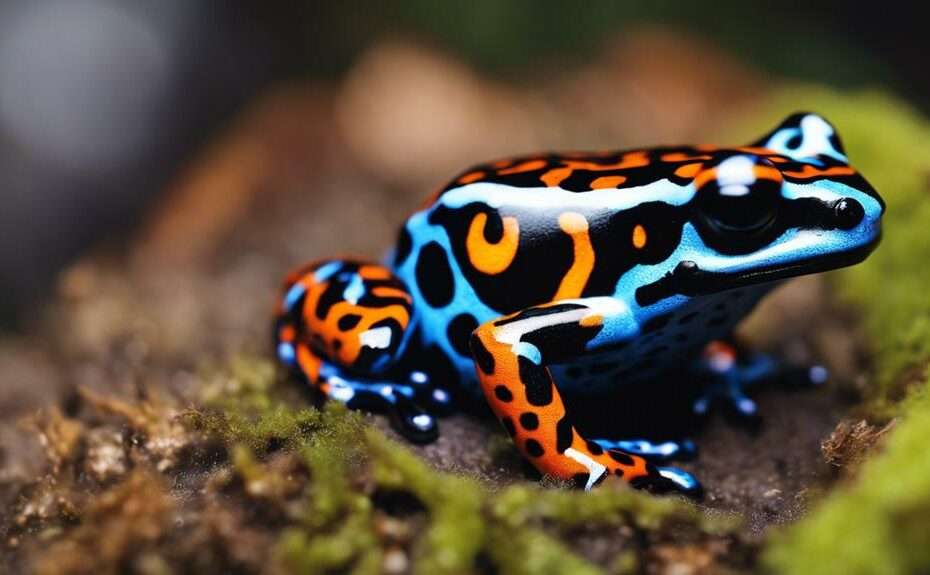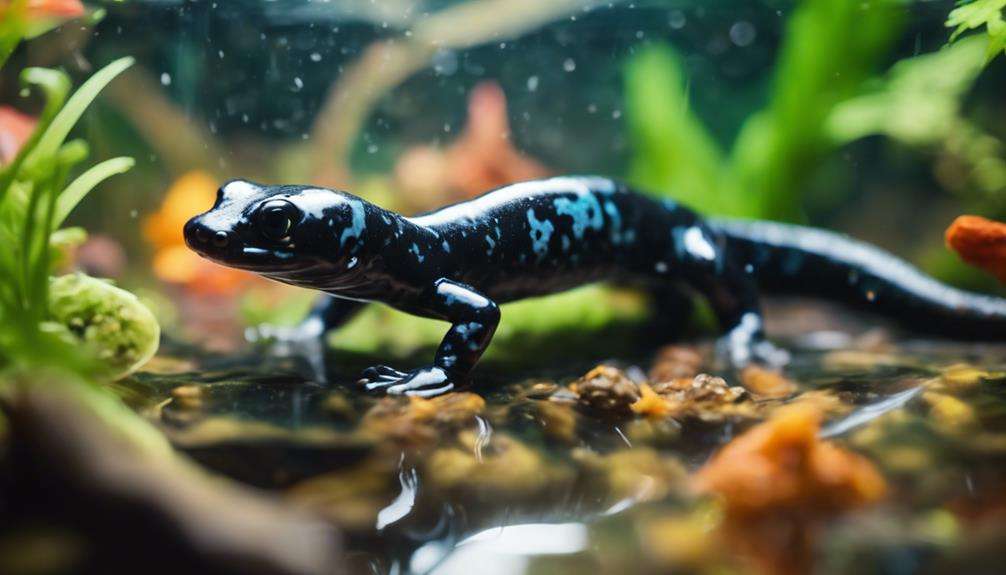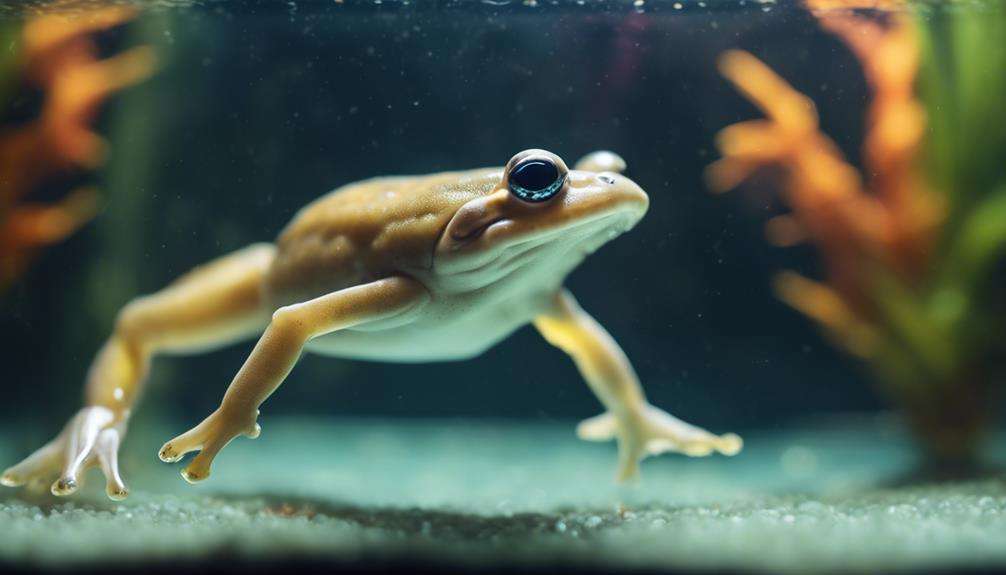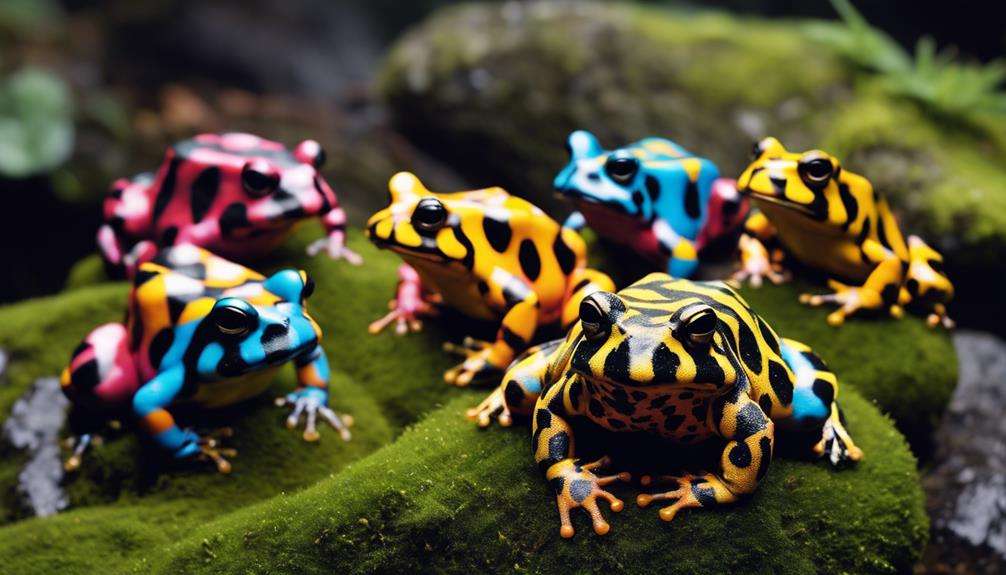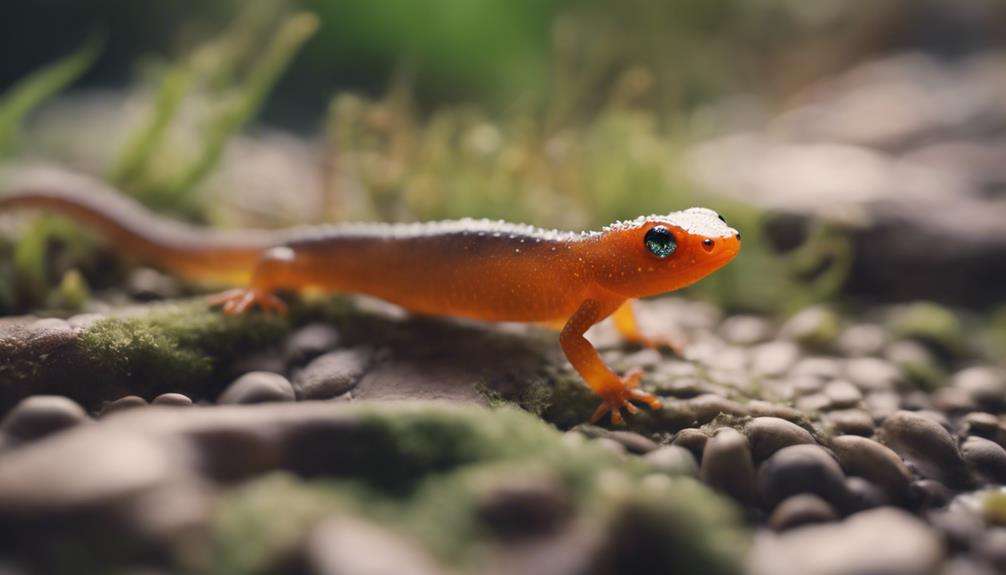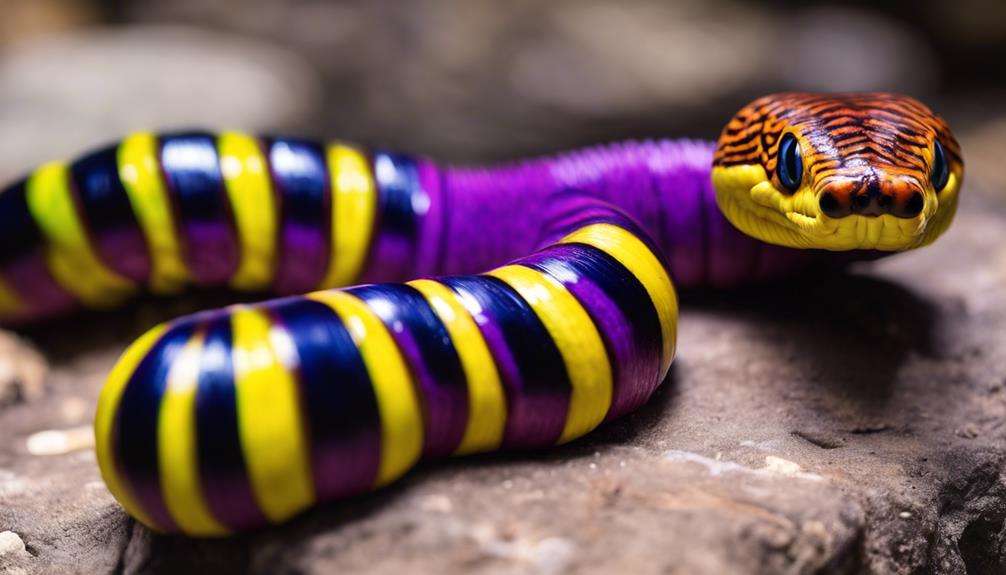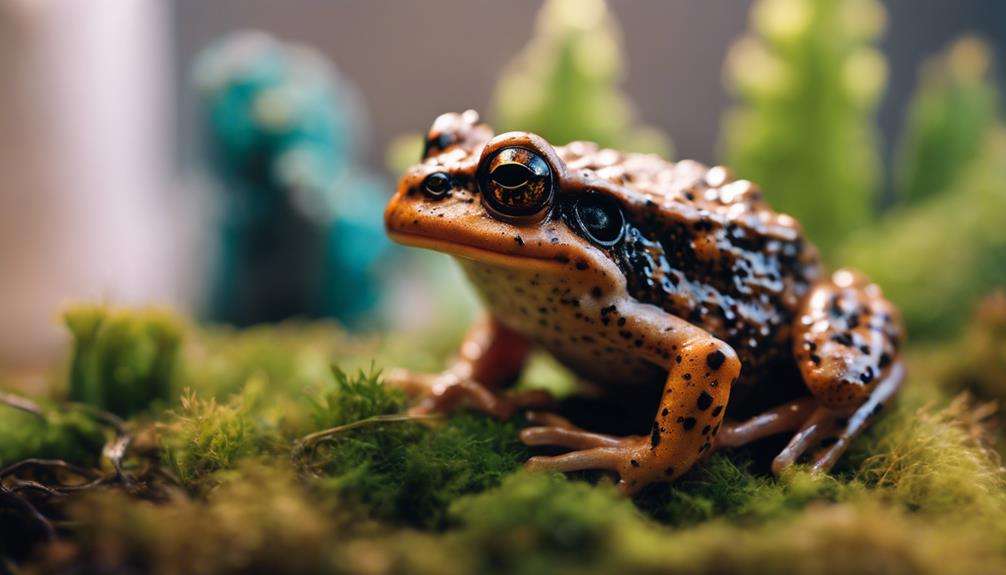Have you ever wondered why some amphibians sport such dramatically distinct markings that seem almost like works of art in nature?
These vibrant patterns serve more than just an aesthetic purpose; they play crucial roles in the survival and reproduction of these fascinating creatures.
From cryptic coloration to bold warning signals, the reasons behind these unique markings are as diverse as the amphibians themselves.
Let's explore the intriguing world of amphibian markings and uncover the secrets behind their striking appearances.
Key Takeaways
- Distinctive markings in amphibians serve as warning signals to predators and communicate toxicity.
- These markings are essential for survival, aiding in camouflage, defense, and species identification.
- Evolutionary adaptations showcase survival strategies like mimicry and visual deception.
- Colorful skin patterns in amphibians have functional roles in communication, camouflage, and warning of toxicity.
Exotic Amphibians With Vibrant Patterns
Exotic amphibians with vibrant patterns, such as the red-eyed tree frog and the blue poison dart frog, showcase striking colorations that serve as visual warnings to predators. These eye-catching hues play a crucial role in deterring potential threats in their habitats.
The red-eyed tree frog, with its vivid green body and contrasting red eyes, sends a clear signal to predators that it isn't to be messed with. This coloration is a bold proclamation of its toxicity and serves as a visual deterrent against would-be attackers.
Similarly, the blue poison dart frog's dazzling blue skin, adorned with stark black spots, boldly advertises its poisonous nature. This warning coloration effectively communicates danger, steering predators away from a potentially lethal encounter.
The vibrant patterns exhibited by these exotic amphibians aren't merely for aesthetic purposes; they're essential tools in the intricate dance of survival in the wild.
Unique Markings in Amphibians
Distinctive markings on amphibians serve as crucial identifiers in research studies, aiding in tracking movement patterns and behavior for insightful analysis. These markings are essential for individual identification, allowing researchers to monitor specific animals over time. By utilizing color patterns and unique markings, scientists can distinguish between different amphibians within a population accurately. These distinctive features are particularly valuable in studying species that exhibit natural variations in their coloration, as they offer a reliable method for marking and tracking individuals.
In research studies, specific color combinations or patterns are often used to mark amphibians, enabling researchers to follow their movements and behaviors. By analyzing these unique markings, researchers can gain valuable insights into population dynamics, social interactions, and habitat preferences of amphibians. Understanding individual identification through distinctive markings is crucial for conducting comprehensive studies on amphibian ecology and behavior. Through careful observation and documentation of these markings, researchers can uncover important information that contributes to the broader understanding of amphibian biology and conservation.
Strikingly Marked Amphibian Species
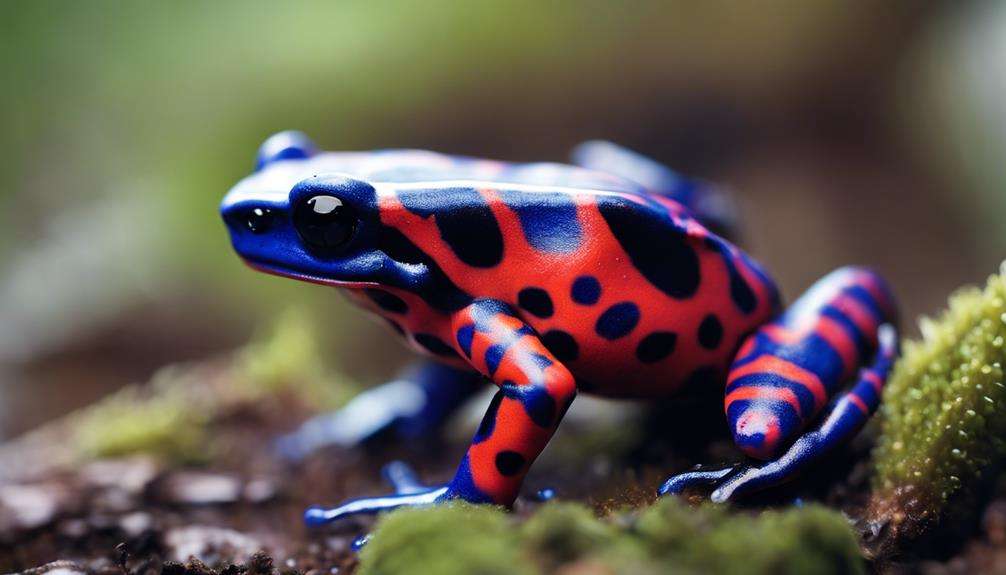
Marked by vibrant colors and unique patterns, certain amphibian species exhibit striking visual characteristics that serve to both warn predators and aid in camouflage within their natural habitats.
- The golden poison frog, with its bright yellow skin, warns predators of its toxicity, making it one of the most dangerous amphibians.
- The fire salamander's black and yellow markings, steeped in mythological associations with fire, serve as a visual deterrent to potential threats.
- The blue poison dart frog's vibrant blue skin, adorned with black markings, acts as a warning signal, cautioning predators of its poisonous nature.
- The marbled salamander's distinct black and white banding patterns provide effective camouflage in the dappled light of the forest floor, helping it blend seamlessly into its surroundings.
These salamanders and frogs showcase the diversity of distinctive markings in the amphibian world, each adaptation finely tuned to enhance survival in their respective environments.
Distinctive Patterns on Amphibians
Distinctive patterns on amphibians, such as stripes, spots, and blotches, play crucial roles in their survival. These patterns have evolved over time, serving as both protective mechanisms and species identifiers.
Evolution of Markings
The varied patterns adorning amphibians have evolved over time, playing crucial roles in their survival strategies and interactions with predators. These distinctive markings are a result of the intricate process of evolution, shaped by natural selection and environmental pressures.
- Camouflage for Survival: Distinctive patterns help amphibians blend into their surroundings, making it harder for predators to spot them.
- Signaling Toxicity: Evolutionary pressures have led to the development of unique patterns that signal toxicity or unpalatability to potential predators.
- Defensive Mimicry: Some amphibians mimic dangerous or venomous species through their markings, deterring predators through mimicry.
- Warning Signals: Bright, contrasting patterns on amphibians act as warning signals to predators, indicating their toxicity or distastefulness.
Camouflage and Warning
Camouflaging among amphibians is a sophisticated survival strategy that involves intricate patterns designed to blend seamlessly into their natural habitats. These distinctive markings not only aid in camouflage but also serve as warning signals to predators. Bright colors and patterns, like those seen in dart frogs, indicate toxicity, deterring potential threats.
Amphibians like the fire salamander display bold patterns to signal their potential toxicity or unpalatability, providing a visual cue for predators to avoid them. By mimicking elements in their environment such as leaves or bark, these unique markings offer protection from being detected. Additionally, these patterns can assist in species recognition, communication, and mate attraction within amphibian populations, enhancing their overall survival and reproduction.
Species Identification Patterns
In the intricate world of amphibians, species identification patterns play a crucial role in research and monitoring efforts, aiding in tracking population dynamics and behavior.
- Distinctive patterns on amphibians aid in individual identification for research and monitoring purposes.
- These markings help researchers track population dynamics, movement patterns, and behavior.
- Unique markings on amphibians can be species-specific and serve as a natural form of identification.
- Researchers use these patterns to differentiate between individuals without the need for invasive methods.
The coloration, spots, stripes, or other markings on amphibians can be unique to each individual, facilitating accurate data collection and analysis. These species-specific patterns are essential tools in the scientific study of amphibians, enabling researchers to study and protect these fascinating creatures effectively.
Rare Amphibians With Bold Markings
Rare amphibians with bold markings, showcasing intricate patterns and vibrant colors, often rely on these distinct features for survival in their natural habitats. These rare species have evolved to use their bold markings as a form of aposematism, a warning signal to predators about their toxicity.
For example, the golden poison frog displays striking yellow hues as a clear indicator of its noxious nature. These markings not only deter potential threats but also serve a dual purpose by aiding in camouflage, allowing the amphibians to blend seamlessly into their surroundings.
The intricate patterns found on these rare amphibians not only contribute to their individual species recognition but also play a crucial role in their differentiation within the wild. By utilizing these bold markings, these amphibians have developed a unique survival strategy that highlights the fascinating ways in which nature has equipped them to thrive in their environments.
Noteworthy Markings in Amphibians
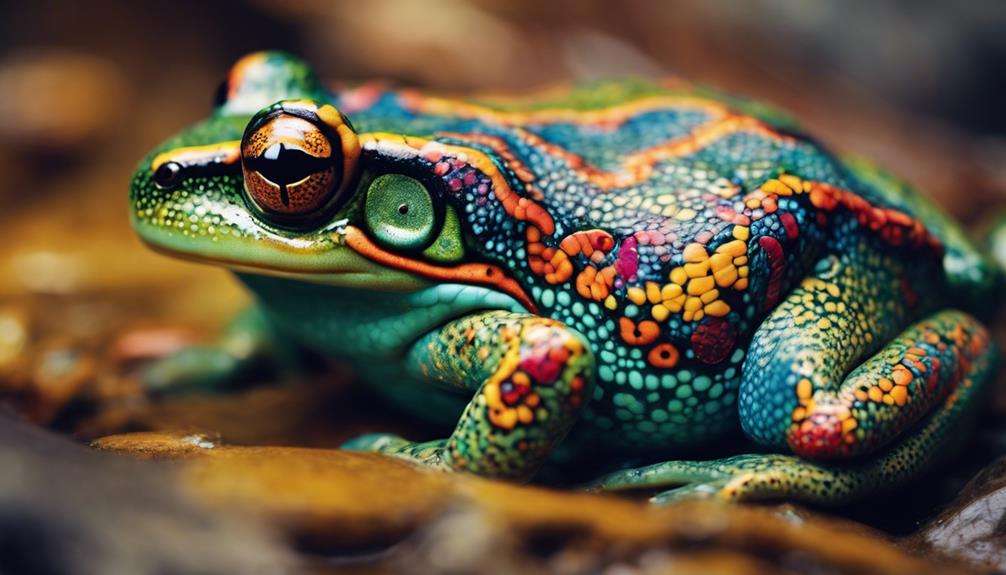
You can notice a variety of colorful skin patterns on different amphibian species, each serving a specific purpose in their natural environment.
Observing camouflage techniques in amphibians can reveal fascinating adaptations for survival and predation.
The significance of these unique markings extends to aiding researchers in species identification and understanding the intricate relationships within amphibian populations.
Colorful Skin Patterns
Displaying a vast array of intricate designs and bold, contrasting colors, colorful skin patterns in amphibians play crucial roles in camouflage, warning signals, and species recognition. These skin patterns aren't merely decorative but serve important functions in the survival and communication of amphibians. Here's why these colorful skin patterns are significant:
- Species Identification: The unique patterns and colors help differentiate between different species of amphibians.
- Visual Communication: Amphibians use their skin markings to communicate with other individuals, especially during mating rituals.
- Camouflage: Some amphibians blend into their surroundings using their skin patterns to avoid predators.
- Warning Signals: Bright and contrasting colors can act as a warning to potential predators about the toxicity of certain amphibians.
These intricate skin patterns are essential for the survival and reproduction of amphibians in their natural habitats.
Camouflage Techniques Observed
Noteworthy markings observed in amphibians demonstrate remarkable camouflage techniques, allowing these creatures to blend seamlessly into their natural surroundings. Distinctive markings play a crucial role in the survival of amphibians by helping them avoid predators through visual deception.
These markings often mimic elements such as leaves, bark, or moss, aiding in their cryptic appearance. Some species have evolved patterns that break their outline, making it harder for predators or prey to detect them. The unique markings serve as a form of visual defense, enhancing the amphibians' ability to evade detection and potential harm.
Through these camouflage techniques, amphibians showcase the incredible adaptations that have evolved over time to ensure their survival in a wide range of habitats.
Significance of Unique Markings
Distinctive markings found on amphibians play a crucial role in individual identification for research and monitoring purposes, aiding in tracking movements, behaviors, and population dynamics of marked amphibians. These unique markings are significant for the following reasons:
- Individual Identification: Specific patterns and colors help differentiate between amphibians in the wild.
- Behavioral Studies: Researchers utilize distinctive markings to study breeding habits, territorial behavior, and migration patterns.
- Long-Term Monitoring: Noteworthy markings are essential for conducting prolonged studies and conservation efforts focused on understanding population trends.
- Research Accuracy: Unique markings provide researchers with accurate data for analyzing population dynamics and ecological interactions in amphibian communities.
Frequently Asked Questions
What Are the Marking Techniques Used in Amphibians?
When marking amphibians, various techniques are employed, such as color patterns for identification, camouflage methods for survival, and warning signals for defense. These strategies assist researchers in tracking, studying, and understanding amphibian populations.
Why Are All Amphibians Considered Good Indicator Species?
Amphibians serve as excellent environmental indicators due to their sensitivity to changes. Their presence or absence can signal habitat loss, climate shifts, and overall biodiversity. Monitoring them aids in understanding and protecting ecosystems, guiding conservation actions.
What Makes Amphibians Distinctive?
Amphibians showcase a wide array of distinctive markings. These serve various purposes like camouflage patterns aiding in blending with surroundings, warning colors deterring predators, and mimicry strategies fooling others. The diversity in markings reflects their ecological roles.
What Is the Rarest Amphibian in the World?
The Gastric-brooding Frog, once the rarest amphibian, faced extinction due to habitat loss and pollution. Conservation efforts, including breeding programs, aimed to preserve genetic diversity, but sadly, all known individuals perished, emphasizing the urgency of protecting rare species.
Conclusion
You may find it intriguing that the distinctive markings seen on some amphibians serve a vital purpose in their survival and reproduction.
These vibrant patterns aren't merely for aesthetic pleasure, but rather play a crucial role in their ecological interactions.
From camouflage to warning signals, these unique markings are a testament to the evolutionary adaptations of amphibians in diverse habitats.
So next time you encounter a boldly marked amphibian, remember the intricate dance of nature at play.
